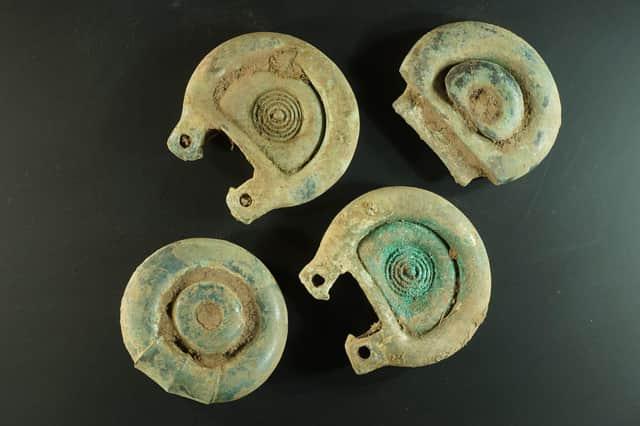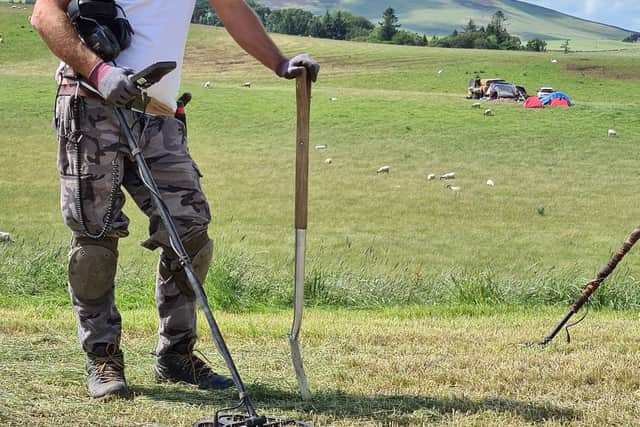Mystery of the decorated Bronze Age horse at the heart of Peebles hoard


The discovery of the horse’s harness along with a complete sword in a field near Peebles last month has been hailed as a discovery of national significance.
The find throws more light on Bronze Age life and culture with the harness one of the earliest pieces of evidence of the domestication of horses in Scotland with the animal seemingly taking an extra special place in the life of this community.
Advertisement
Hide AdAdvertisement
Hide AdThe rattle pendant, which was hung from the harness straps and made a noise as the horse moved, is the first to be found in Scotland.


The horse is likely to have been a show of power in this Peebleshire community that may have been made up of six or seven dwellings and lived in by well-connected agriculturalists and craftspeople who enjoyed links to other countries.
Dr Matthew Knight, curator of Prehistory at National Museum of Scotland, said: “Having a horse would have been a symbol of power and the sword speaks to that as well.
“To deck out a horse in this harness is part of this expression of power.
"When you think about the rattle pendant, you can imagine the horse jangling as it moves. This wasn’t just about harnessing your horse, this was about making sure that it was decked out. This was about showing off your horse.”
However, Mr Knight said the horse may have been a communal animal and not necessarily that of a leading figure in the community.
He added: "We shouldn’t jump the conclusion that this was the horse of a tribal leader. It may have been, but we don’t know this yet.”
Intriguingly, the harness, sword and other items in the hoard were discovered buried in a wall which once formed part of a building made from timber.
Advertisement
Hide AdAdvertisement
Hide AdThe building was likely dismantled or destroyed before the harness was left in the remaining wall, it is understood.
"We don’t know the extent of the building or what it was used for but it may have been part of a small setttled community of agriculturalists and crafts people that would have had connections across the landscape and and with other communities,” Dr Knight added.
The objects may have been ‘given up’ following the death of the owner or perhaps as the community decided to move on from their settlement.
Dr Knight added: “If you have a complete horse harness and sword, then you are also making a powerful gesture by giving them up . These items hold a lot of bronze, a lot of organics, such as leather, and it takes time and effort to make them.
“To offer them up is a significant action.”
“We are still working of the interpretation of these items but it is entirely possible that the person who owned these items died and then it was seen as necessary to bury these things.
“Similarly, it could also be about moving on with the feeling that ‘this settlement has provided well for us, and here is an offering’.”
The Peebles find was made more than 150 years after a horse harness was discovered by a shepherd at nearby Hopehorse Craig, which sits to the south west of the town. The items found here, in 1864, were more connected to a cart or wagon rather than being fitted directly to the horse.
The design of the recent find suggests that the communities of the time were well connected with links possible to the Continent.
Advertisement
Hide AdAdvertisement
Hide AdDr Knight added: “These harnesses are extremely rare, there is very little like it in Scotland and some of the items found are better compared to northern England.
“We are looking at a well-connected community, with the design of the items suggesting links to Ireland and Continental Europe.
"It is likely that these people had never seen objects like this before.”
Analysis of wood and leather that made up the Peebles harness is set to offer up accurate dating on the objects and more information about the type of animals kept.
Further excavation on the site to extract more information on the building where the harness was buried is also likely.
Dr Knight said: “The hoard found at Peebles has much more information to offer us. Further interpretation and analysis will help us build a picture around these items and give us a much deeper connection to the people of the past.
"Until the site has been fully excavated, one of the most exciting things is that we just don’t know what it can tell us yet.”
A message from the Editor:
Thank you for reading this story on our website. While I have your attention, I also have an important request to make of you.With the coronavirus lockdown having a major impact on many of our advertisers - and consequently the revenue we receive - we are more reliant than ever on you taking out a digital subscription.Subscribe to scotsman.com and enjoy unlimited access to Scottish news and information online and on our app. With a digital subscription, you can read more than 5 articles, see fewer ads, enjoy faster load times, and get access to exclusive newsletters and content. Visit https://www.scotsman.com/subscriptions now to sign up.
Advertisement
Hide AdAdvertisement
Hide AdOur journalism costs money and we rely on advertising, print and digital revenues to help to support them. By supporting us, we are able to support you in providing trusted, fact-checked content for this website.
Joy Yates
Editorial Director